 artists
artists
GUDEBERGJORDET - A LAND OF COUNTLESS VOICES.
An Agency for the More-than-humans. by Eva Bubla
02/07/2024
As one of the invited IN SITU artists to have artistic explorations related to an upcoming public art triennial of Østfold Internasjonale Teater (ØIT), I had my first visit to Fredrikstad in the beginning of 2022.
The invitation was fascinating, as the curatorial concept of James Moore built on the book “The Forest Unseen” by David George Haskell, in which the biologist author is examining the local ecosystem by setting up small circles of observations. For the triennial, the circle was planned to be expanded for as big of a radius as 30 km around Fredrikstad, to give space for various artistic explorations and interventions in a very diverse environment. During my first visit I learned about possible locations, met local citizens, organizations, and experts with the purpose of mapping local themes and ecological knowledge that could form the basis of my proposed project. My interest quickly turned towards an agricultural area within the city, called Gudebergjordet - a monoculture farm surrounded by industrial land, residential houses, a tiny lake and reed beds - due to its complexity and political potential.
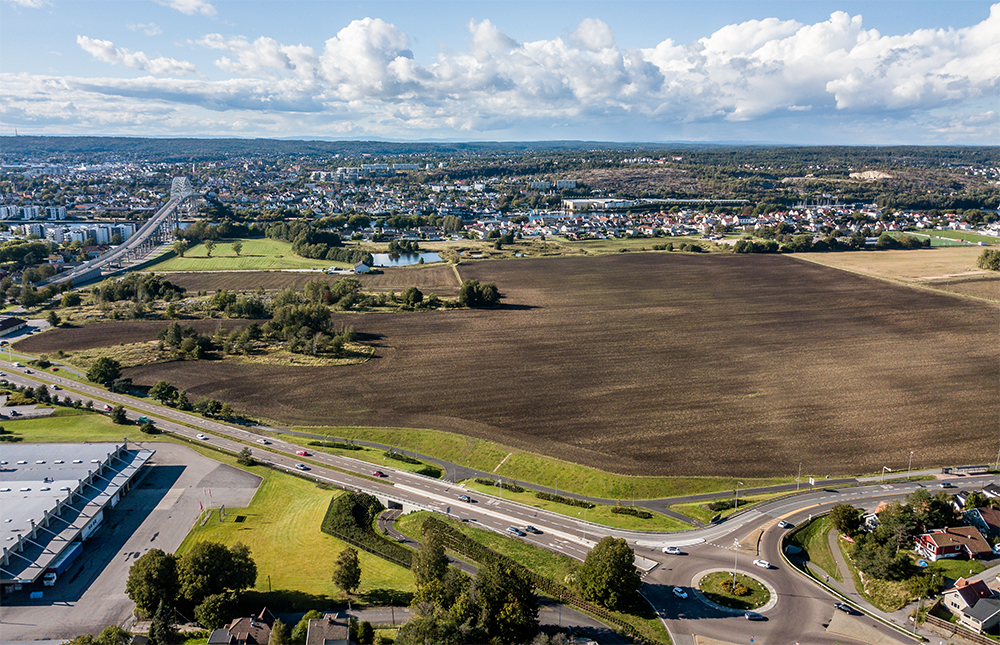 Gudebergjordet. Photo: Terje Holm / Østfold Internasjonale Teater | Land areas are decreasing rapidly in urban environments. Changing climatic conditions, soil loss, population growth and political unrest threaten food security globally. Norway is well-known for its abundant nature and boreal forests covering most of its area. However, as I was told, only 3% of its total territory is arable land, making it one of the least self-sufficient countries in terms of food production. The world grows 95% of its food in the uppermost layer of soil, making topsoil one of the crucial elements of our food system. Unfortunately, half of premium quality topsoil has disappeared in the last 150 years due to conventional farming practices, risking crop yields and contributing to erosion, degradation of microbial life, loss of biodiversity, and nutrient pollution. According to Maria-Helena Semedo of the UN’s Food and Agriculture Organization, if we continue at this rate, the world could run out of topsoil in little more than half a century. This would severely damage the earth’s ability to filter water, absorb carbon, and feed people. |
The topsoil at Gudebergjordet is of premium quality, consisting of silty-fine sand and silty loam that was deposited in the sea and raised above sea level after the ice retreated, making it a fertile agricultural area and as such, a treasured national value. It has been part of the city’s fields since Fredrikstad was laid out in 1567 and the land has most likely been used for food production even long before that. Today, it is used to grow grains for feeding livestock, but it would be suitable to grow vegetables as well. However, this valuable plot of land is not on the mental map of people. Therefore, for the invitation of Østfold Internasjonale Teater, I started to look for an artistic framework which could engage citizens to think and relate to Gudebergjordet in a different way. | |
| My first two short research trips were focusing on talking to local citizens, organizations, experts, and the farmer who rents and cultivates the organic monoculture farm at Gudebergjordet. Based on these first interactions, my initial vision became creating a biodiverse farm area in one part of Gudebergjordet, a kincentric garden with artistic elements and curated activities, in collaboration with local partners and other artists. A kincentric garden is one which builds on a kind of kinship between human and non-human elements, where soil and plants are not only regarded as resources, but where a microecosystem is created for the benefit of all. It promotes biodiversity instead of monoculture, using dynamic populations of plants in favor of ecological heterogeneity. As such, my starting point was creating a public garden with artistic-curatorial elements that give home to and care for a variety of species, while building a connection to the land and food production. | 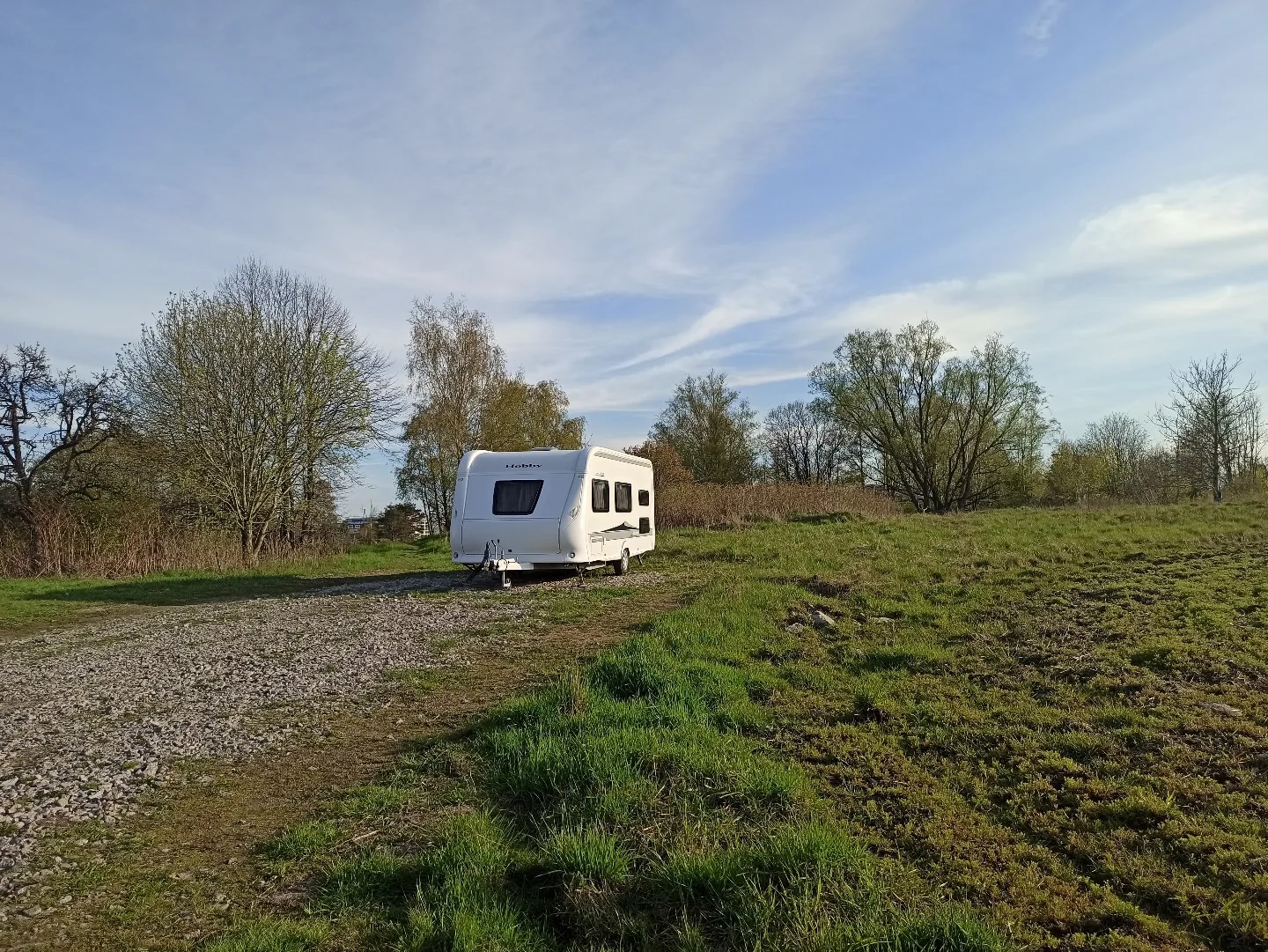 Resting with the Land - a month-long residency on Gudebergjordet, 2023 Resting with the Land - a month-long residency on Gudebergjordet, 2023 |
But soon I realized my own personal connection to the land was still missing. I had piles of research data from interviews, meetings, conversations, articles, but I was still lacking my own conversation with the land, which is equally important to human interactions. I did not want to exploit or exhaust, nor colonize it by invasive artistic objects and aspirations alien to the location, but to listen to the land itself as much as possible. Therefore, to dig deeper, I was able to spend a month-long residency in a caravan on the land of Gudebergjordet, to rest and think with the land, to imagine possible futures from human and more-than-human perspectives, and to invite the public to join the process. | |
When moving to the caravan, I basically arrived into an olfactory installation: a mountain of fertilizer was stored next to the caravan and sprayed all around the fields the next days. I could smell the mixture of chicken and cow dung as agents of “land stories", just like the bird sounds mixed with the sound of heavy traffic.
In the beginning of the residency, I went into complete silence for five days. The first day my observations were rather preoccupied by the instant environment around the caravan, and the life in it: how much water and energy I can save, so that I do not need to refill the water tank too quickly. I reused as much water as possible, the one I used for washing could also go to flush the toilet, the one I used for boiling veggies could cool down and be used to water the seeds that I planted in front of the caravan.
Then gradually, the lack of human communication and the turning off of all electronic devices created the opportunity to fully immerse myself in the area and to carry out detailed observations by opening the senses to experience the land and the creatures that live on, in or around it. Passersby were welcome to join the practice in silence, could tune-in by pre-designed exploratory exercises, or their own intuition. There was an old couple who tried to play a “Norwegian activity game” with me, another man who silently followed one practice, said thanks then left with a smile. A mother with a toddler, who were given the suggestion of exploring the soil below their feet, and touching it, rubbing it, playing with it, and making friends with it - indirectly stepping over the misconception of soil as dirt but exploring it as a living material, rich in microbial life, beneficial for the human health as well. There were also some generally reserved visitors, others more curious.
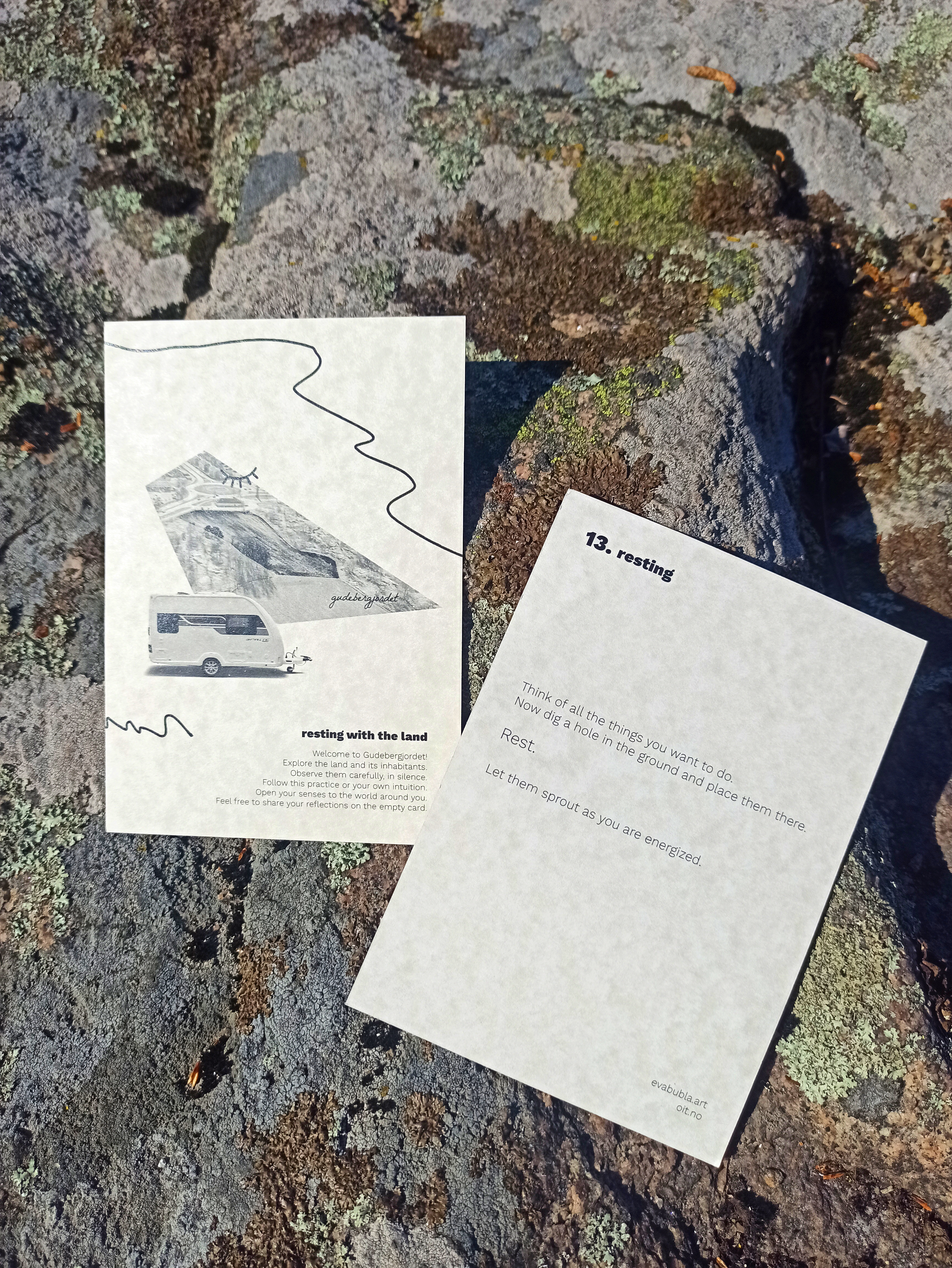 Resting with the Land, exploratory cards, 2023 Resting with the Land, exploratory cards, 2023 | I found various recurring spots for observation, where I spent my morning and evening land meditations. There were times when I picked a card to help me tune in. My first card to pick was “breathing”. I slowed down my breathing and focused on the exchange of air between plants and humans. Another card asked me to rest: “Think of all the things you want to do. Now dig a hole in the ground and place them there. Rest. Let them sprout as you are energized.” So I was just sitting on the rock and releasing any thoughts, trying to just be and embrace the present moment and the spirit of the place. The sun hid behind the clouds, so I started to feel pretty cold, but at the same time, I noticed the various birds around. A couple of tiny brown "farmbirds" were dancing in the middle of the bushes. A magpie was flying up on a tree. Later, there was another one which did not bother to spend long tens of minutes just five meters from me, peacefully having seeds and worms for breakfast. I felt like being on a deserted island, while I was so close to busy roads and city life. I enjoyed this intimacy, and was thinking how people could be brought here without losing this important aspect. | ||
As the days passed, external observations somehow transformed into internal sensations. One evening, while I was watching over the freshly plowed land, my body suddenly dissolved into soil and a strong sensation of motherly feeling appeared to me, as if I could hear the land talking. “Here I am, naked, covered in holes from hot metals. I lay here wide open, ready to create a home for the seeds of future generations. I can bear it. I can bear everything. I can bear even the unbearable. Can I? Do I ever stop to take a rest? Am I allowed to? After all, I need to take care of countless hungry mouths. I am here to feed. I am here to give. Are my resources endless? How fertile is my womb? I ask you, all those tiny creatures of the micro realm, [bacteria, protozoans and fungi,] who constitute me: how do you feel? (...) Mothers are scarce creatures here in the North. There are so many without one, having to travel long distances to find one. I cannot just stop giving. I am needed. Micro-allies, I need you. You are my health. Whirling worms, I need you. You soften my flesh. Green allies, I need you. You cover my skin. You protect me from burning. You keep me hydrated. Seeders, I need you. I need you to listen and feel me. I need you to take good care of me. Be gentle. Feed me well so I can feed you.” | |||
Evolving from the experiences of the silent observations and prior conversations with locals, the conceptual framework started to crystallize: the creation of Gudebergjordet Protection Agency (GPA), a fictional organization and artistic experiment to articulate more-than-human voices and advocate multispecies rights - the legal rights for the complex ecosystem of Gudebergjordet: the land and water bodies, the macro and microorganisms, and as James Moore suggested, the topsoil especially. We had earlier conversations with local ecologist Randy Gunnar Lande and an ornithologist Bjørn Frostad about the possibility of rewilding the area, and turning it into a protected wetland. However, while that might protect it from later city expansion and construction works, the area would lose its valuable agricultural potential. So why not have a protected status for both the surrounding wetland and the agricultural area? To gather and amplify voices and expertise, the Agency is designed to serve as a platform for artistic and farming activities, discussions on land use and land care and advocacy of multispecies rights. | 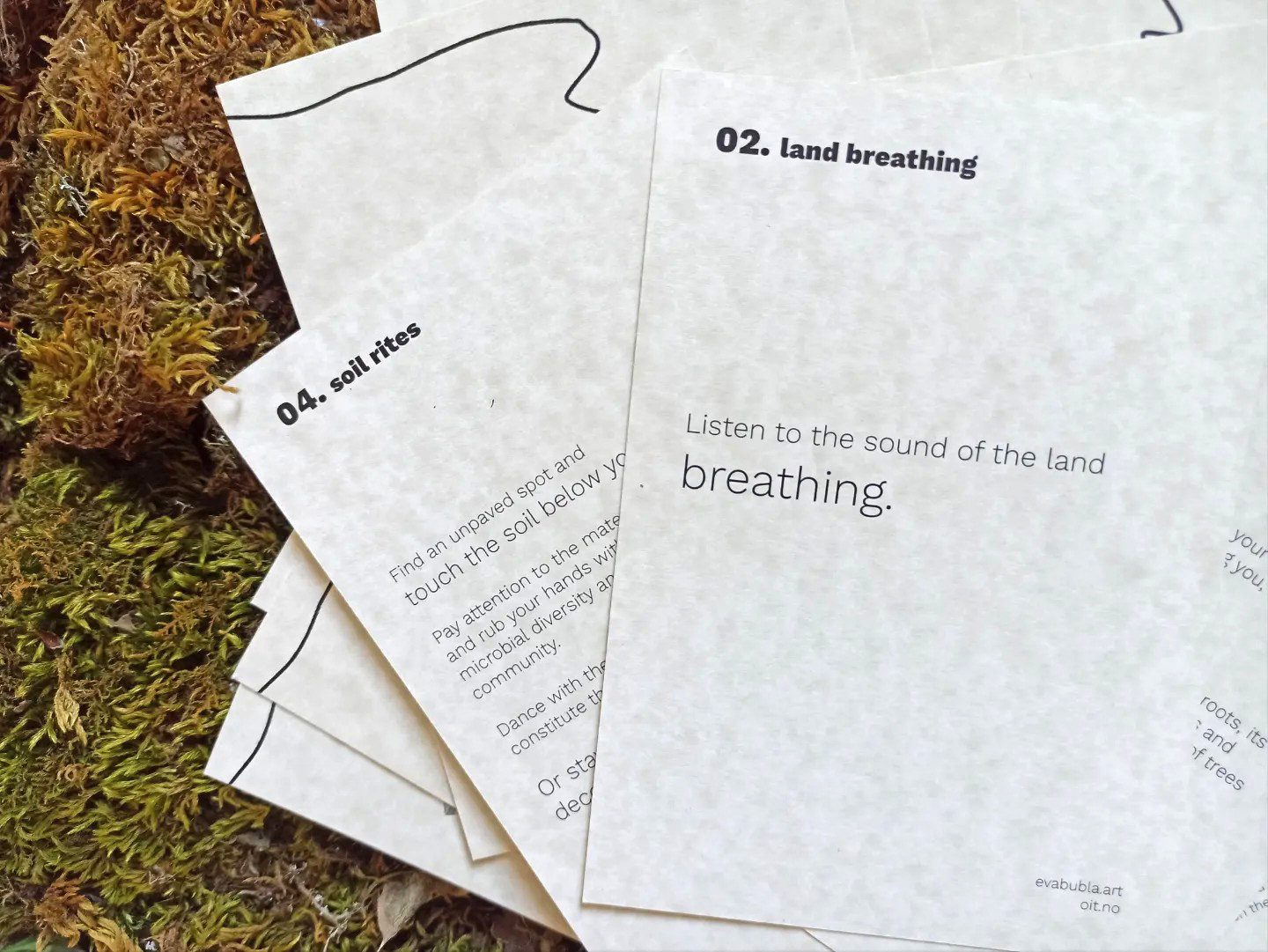 Resting with the Land, exploratory cards, 2023 Resting with the Land, exploratory cards, 2023 | ||
| As each day I returned to the caravan, the feeling of having that location as the spot for the main installation, the "head office" of the Agency got stronger in me. It can host various artistic and citizen activities, while the already planned biodiverse gardening spots can be developed around. | |||
| I held two workshops for local citizens and stakeholders and another two for school kids after my silence, where I shared my experiences of those days while inviting them for the sensory and somatic mapping of the area, as well as introducing the idea of the Agency. We shared thoughts and visions, contemplated on the concept of work and rest, on damaged soil and healing, as well as social conditioning and our concept and understanding of nature, and how we approach it. | 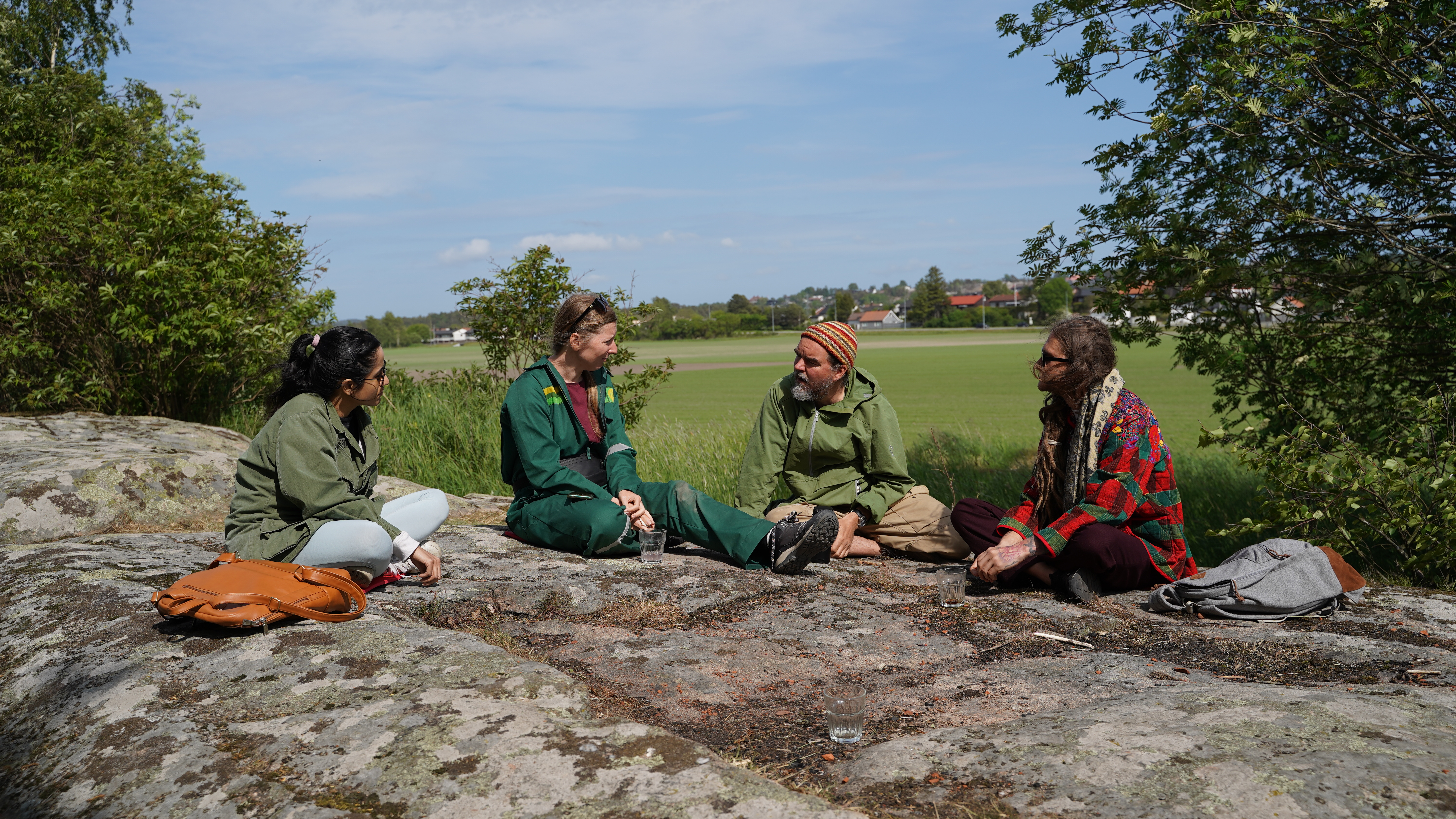 Workshops. Photo: Ida Willassen Workshops. Photo: Ida Willassen |
 Workshops. Photo: Ida Willassen Workshops. Photo: Ida Willassen | |
James Moore also drew my attention to Section 112 of the Norwegian Constitution that states that “Every person has the right to an environment that is conducive to health and to a natural environment whose productivity and diversity are maintained”. I also read that on 28 July 2022, the UN General Assembly adopted a historic resolution, declaring access to a clean, healthy and sustainable environment, a universal human right. While both are arguably of great importance, they still feel insufficient. One of their flaws is that they still approach the issue from a dominantly human perspective. How can we challenge anthropocentrism and human supremacism and instead of articulating our human right to this environment, recognize human and more-than-human life and agency alike; meaning, the rights of the more-than-human as well? The next step of the research and development is elaborating on the kinds of rights those are, and how they can be guaranteed; basically writing a Declaration of the Rights of Gudebergjordet and an Action Plan in our case, together with further artistic and citizen activities that amplify these voices. A public biodiverse garden. Audio installations of the living soil. Earth wombs. Public visual campaigns. | |
 Workshops. Photo: Ida Willassen Workshops. Photo: Ida Willassen |  Workshops. Photo: Ida Willassen Workshops. Photo: Ida Willassen |
During the research process, I learned a lot about various voices, about human/more-than-human, but also human/human power relations, and various approaches to the land and environment. For now, the concept of Gudebergjordet Protection Agency is dormant, however, its principles and methodologies relate to a greater framework as well that can be applied in and developed further in other locations and contexts as well, to think and relate in novel ways to our local and global ecosystem, experiencing the entanglement between species and embodying the principles of multispecies care and multispecies rights. After all, there are a lot of entities to stand up for. Which one(s) would you choose? | |
1 Cosier, Susan. The world needs topsoil to grow 95% of its food – but it's rapidly disappearing. Guardian, 30 May 2019
2 Ulfeng, Hege. Ti fakta om matjorda på Gudebergjordet (Ten facts about the topsoil at Gudebergjordet). Fredrikstad Blad, 23 July 2019
3 UN General Assembly declares access to clean and healthy environment a universal human right. UN News, 28 July 2022

